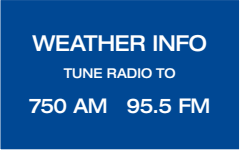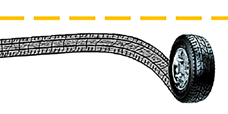
Introduction Continued: Tips for Driving in Adverse Conditions
Tips for Driving in Adverse Conditions
Driver Inattention
Driver inattention is a primary cause of crashes. Distractions, such as interacting with passengers, texting/talking on the phone, or adjusting the radio, are especially dangerous for young drivers. Limit distractions by pulling off the road to perform activities not related to the driving task.
Drowsy Driving
Fatigue or drowsy driving severely limits your reaction time and decision-making ability, and is caused by lack of sleep, the body’s circadian rhythm, and driving for long periods of time. Circadian rhythm is the body’s natural “downtime”, which for most people is between 1 and 5 p.m. and around your normal bedtime. To avoid fatigue, take breaks, keep the vehicle cool, and be aware of your “downtime”.
Glare
Sources of glare include headlights of oncoming or following vehicles, misaligned headlights, improperly loaded vehicles, a dirty windshield, paper on the dashboard, facing the sun at dusk or dawn, snow-covered landscapes, and traditional versus contemporary side mirror settings. To combat glare, wear sunglasses during the day only, adjust sun visor as needed, keep windows clean, reduce speed, and look to the right-hand side of the road when meeting a vehicle with high beam headlights on.
Fog

During foggy conditions, reduce speed, use low beams, windshield wipers, and defroster/ defogger and flashers if needed, and look for a safe area to pull off the road.
Heavy Smoke, Rain, or Snow
Reduce speed, turn on low-beam headlights, emergency flashers, and windshield wipers; make gentle steering, accelerating, or braking actions; be alert for stopped vehicles on the highway, and be prepared for wind gusts or strong steady crosswinds; turn on the radio to monitor weather and road conditions, and if possible, leave the highway.
Low Water Crossing

Nearly half of all flash flood fatalities are vehicle related. In severe rainstorms watch for flooding at bridges and low areas. Driving too fast through low water will cause the vehicle to hydroplane and lose contact with the road surface.
Hot or Cold Temperatures
Hot or cold temperatures place demands on tires, radiator coolant, hoses, connections, and drive belts and increase driving risks. Check these items prior to and after driving during these conditions.
Strong Wind
Strong wind conditions create a problem for drivers called buffeting. This occurs on bridges, through mountain passes and ravines, and when being passed by large trucks. Reduce speed, check traffic, be prepared to steer windward, and countersteer in the direction you want the vehicle to go.
Head-On Crashes
The possibility of serious injury or death is greater in a head-on crash. This type of crash is more likely to occur on two-lane highways, in narrow lanes or on curved roads, and in construction zones.
Rear-End Crashes
Rear-end crashes are one of the most common types of multiple-vehicle crashes. Tailgaters cause many rear-end crashes. Adverse conditions such as dense fog or smoke, heavy rain, and snow also increase risks to motorists because some drivers stop their vehicles while still on the highway.
Side-Impact Crashes
Most vehicles are not well-equipped to withstand a side impact. If your vehicle is in danger of being hit, your best option is to accelerate rather than apply brakes if the way ahead is clear.
Changing Traction Conditions

Traction or adhesion is the grip the tires have on the road surface, which allows the vehicle to start, stop, and/or change directions. As speed increases, traction between the tires and the road decreases. Three kinds of traction influence motor vehicle control: static, rolling (dynamic), and sliding. Road surface conditions that decrease the level of traction are ice, snow or frost, wet surfaces or standing water, mud or wet leaves, uneven surfaces, sand, gravel, and curves. Speed should be reduced in such conditions.
DDS 2 GO Mobile App
Download our new free mobile app!
"It's like having a licensing office in your pocket!"
- Reinstatements
- Motor Vehicle Report
- Renewal
- Replacement
- Change of Address
- Custom Alerts
- Locations
- Pay fees
- And more!
Available on the Apple App Store and Google Play.